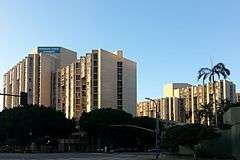Peter Kamnitzer
| Peter Kamnitzer | |
|---|---|
| Born |
1921 Berlin, Germany |
| Died |
June 25, 1998 Los Angeles, California, U.S. |
| Cause of death | heart attack |
| Alma mater |
Columbia University Harvard University |
| Occupation | Architect |
| Spouse(s) | Marietta Kamnitzer |
| Children | 2 sons |
Peter Kamnitzer (1921–1998) was a German-born American architect. Born in Germany, he emigrated first to Israel and secondly to the United States, where he settled in Los Angeles, California. He was a Professor of Architecture at the University of California, Los Angeles (UCLA). With NASA and General Electric, he invented a graphic design tool used to predict what impact buildings would have on environments. He was a proponent of adding greenery and leisurely facilities to apartment complexes. He designed many residential buildings in Downtown Los Angeles, including public housing.
Early life
Peter Kamnitzer was born in 1921 in Berlin, Germany.[1] He emigrated to Israel.[1] By 1949, he emigrated to the United States.[1] He received a master's degree in planning and housing from Columbia University in 1951, followed by a master's degree in architecture from Harvard University in 1957.[2][3]
Career
Kamnitzer started his career at the National Planning Department for the Government of Israel.[2] He subsequently worked for El Salvador's National Medical Center, followed by the United Nations Housing Section.[2]

Kamnitzer became an architect in Los Angeles, California, where he first worked for Gruen Associates.[2] During that time, he designed Wilshire Terrace, a residential building on Wilshire Boulevard.[2] Shortly after, he co-founded the architectural firm Kamnitzer, Marks & Partners, later known as Kamnitzer & Cotton, and Kamnitzer Cotton Vreeland.[1][2] He designed many high-rise residential buildings in Downtown Los Angeles, including housing projects.[1] He designed Promenade Towers in Bunker Hill, Los Angeles.[4] He also designed the Keck Theater on the campus of Occidental College.[1]
In a speech he gave to the National Association of Home Builders International Conference of Apartment Developers in 1970, Kamnitzer called for the development of full living environments, by building apartment complexes with retail facilities, tennis courts, swimming pools, childcare centers, and even park-like features like "rushing waterfalls, secluded walkways, meandering streams and lush greenery".[5]
Additionally, Kamnitzer was a Professor of Architecture at the UCLA School of the Arts and Architecture from 1965 to his death.[1] He was also a Visiting Professor at the University of Southern California.[1] He also worked for NASA in the later 1960s.[6] By 1970, with NASA and General Electric, he had developed a graphic design tool to anticipate the effects of planned buildings.[7][8]
Personal life and death
Kamitzer had a wife, Marietta, and two sons, David and Jordan.[1] He died on June 25, 1998.[1]
References
- 1 2 3 4 5 6 7 8 9 10 Oliver, Myrna (June 30, 1998). "Peter Kamnitzer; Architect of High-Rises and Housing Projects". The Los Angeles Times. Retrieved June 28, 2016.
- 1 2 3 4 5 6 "Peter Kamnitzer, Urban Planning: Los Angeles". Calisphere. California Digital Library. Retrieved June 28, 2016.
- ↑ "Beauty Awards Speaker Set". Pasadena Independent. January 24, 1966. p. 24. Retrieved June 28, 2016 – via Newspapers.com. (Registration required (help)).
- ↑ De Wolfe, Evelyn (July 28, 1985). "Promenade Aims to Set Urban Life Style : Downtown Gets Its First Privately Developed Apartments in 16 Years". The Los Angeles Times. Retrieved June 28, 2016.
- ↑ "Apartment Must Meet Environment Demands". Progress Bulletin. October 25, 1970. p. 21. Retrieved June 28, 2016 – via Newspapers.com. (Registration required (help)).
- ↑ Groves, Martha (April 1, 2016). "Seeing is Believing". UCLA Magazine. Retrieved June 28, 2016.
- ↑ Brail, Richard K.; Klosterman, Richard E. (2001). Planning Support Systems: Integrating Geographic Information Systems, Models, and Visualization Tools. Redlands, California: ESRI Press. p. 388. ISBN 9781589480117. OCLC 47023496.
- ↑ De Monchaux, Nicholas (2011). Spacesuit: Fashioning Apollo. Cambridge, Massachusetts: MIT Press. p. 300. ISBN 9780262015202. OCLC 642351481.